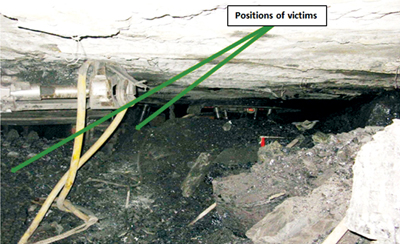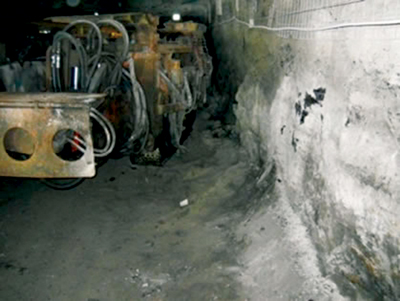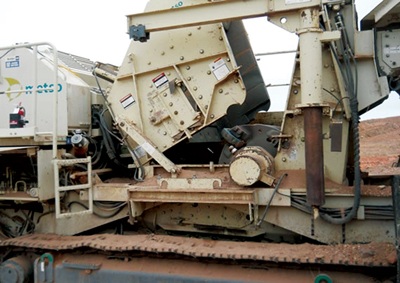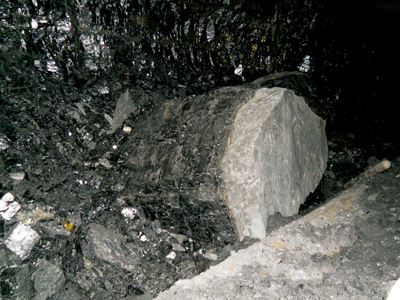IN MANY WAYS, A REVIEW OF 2Q FATALITIES IN COAL LEAVES MORE QUESTIONS THAN ANSWERS
By Donna Schmidt, Field Editor
Safety-wise, the U.S. coal industry fell below expectations in the second quarter; five coal miners were killed on the job, and one incident was a double fatality — something U.S. coal hasn’t seen in years. On the surface, it doesn’t look like there is a link in trends between these incidents and others recorded this year. However, all have happened more than once before in one manner or another, with the scenarios eerie reminders of those past events, and there is, in fact, something to learn from each one.
Despite three fatals in metal/nonmetal mining in April alone, the month was the only one in coal in the second quarter that wasn’t marred by a fatal accident. There was no favored location — two deaths were recorded in Appalachia, one in the Illinois Basin and two were in the western coalfields — and the four events that led to the fatalities were an even split between surface and underground operations.
There was little similarity in the victims’ age range; two were in their 20s, two in their 40s and one worker was 58. Of the four events, three involved machinery or powered haulage.
Perhaps the most alarming dots that can be connected amongst those incidents that took five lives in three months is the fact that only one of the workers had more than five years of experience. In fact, the average experience of the group’s four workers with the least time on the job was about 2.6 years, and one individual had been in mining just 24 weeks.
It is painfully obvious that, the events that led up to the deaths (though this is preliminary, as no final investigation reports have yet been released for any of the following) could all have gone in a different direction and the respective deaths could have been avoided.
Brody Mining, Coal Rib Burst — May 12
 |
| A CM operator and roof bolter/MRS operator were killed May 12 at Patriot Coal’s Brody No. 1 mine in Boone County, West Virginia. |
For the first time since 2011, there was a fatality in coal on May 12 that involved more than one person. That was the day that continuous miner operator Eric Legg and roof bolter/MRS operator Gary Hensley were killed while pulling pillars and extracting coal at Patriot Coal’s Brody No. 1 mine in Boone County, West Virginia. They were the fourth and fifth coal deaths of the year.
In its preliminary report, the Mine Safety and Health Administration (MSHA) indicated that there was a coal/rock outburst on the No. 5 entry of the 4 East Mains panel. The room-and-pillar operation was of an average size, employing 193 with 171 underground.
In its fatalgram alert on the incident, the agency went on to say that crews were mining the second lift of the left pillar block at the time of the rib burst, and stressed the frequent and thorough examinations of mine roofs, faces and ribs in the wake of the incident. MSHA inspectors also highlighted the importance of following roof control plans (RCPs)and training all miners on the specifics of proper compliance to RCPs.
While the retreat mining practice was not mentioned specifically in the agency’s best practices, officials did allude to mines’ need to ensure suitable pillar dimensions and mining method for a given area, and that roof and rib control is adequate for the depth of cover where work is being performed. MSHA also noted that a geological feature map should be developed, including unusual conditions, to determine the best mining plan to address potentially adverse roof and rib conditions.
M-Class MC No.1, Pinning — May 14
 |
| Roof bolter William-Daniel Payne received fatal injuries on May 14 in Illinois when he was pinned between a bolter and the rib while tramming. |
Just two days after the deaths in southern West Virginia, the sixth coal fatality was reported at an Illinois underground operation owned by Foresight Energy. Roof bolter William-Daniel Payne, 25, received fatal injuries the afternoon of May 14 when he was pinned between a roof bolting machine and the rib as he was tramming the bolter. MSHA said in its preliminary findings that Payne was near the roadway to the longwall tailgate section of the mine’s Viking Portal No. 1, where the section equipment was being removed from the longwall setup rooms.
The miner was found on the left side of the roof bolter, between the machine and the rib.
Awareness of pedestrians in a machine’s turning radius was at the top of MSHA’s best practices guide in the weeks following the fatality, as was a reminder for operations to install proximity protection systems to protect personnel.
Peabody Energy North Antelope Rochelle, Impact Crusher Death — June 4
 |
| A miner was crushed between the hood and frame of a horizontal impact crusher at the North Antelope Rochelle mine in Wyoming June 4. |
June was less than a week old when equipment operator Joshua Wishard lost his life in a machinery accident while working at Peabody Powder River Mining’s North Antelope Rochelle complex in Campbell County, Wyoming, a top producing mine with the nation’s largest coal payroll at 1,517.
In its initial findings following the June 4 incident, MSHA did not elaborate on the scenario leading up to the 5:35 a.m. event, but did confirm that the victim was crushed between the hood and frame of a horizontal impact crusher at the mine’s Rail Loop East Scoria crusher pit. It was not until the agency released a fatalgram safety alert for the fatality that it was revealed Wishard was clearing a rock from the crusher area when the incident occured.
The death was not only the second one in less than a month, but it also involved another 25-year-old miner. Wishard had only 24 weeks of mining experience.
In its best practices, federal investigators included several reminders for mining operations on safe working conditions and blocking material safety, but it also stressed the importance of monitoring all personnel — and especially miners new to a task — to ensure safe procedures are followed. It also highlighted the practice of de-energizing and locking/tagging out all power sources before working on equipment.
Cloud Peak Energy Spring Creek Coal, Haul Truck Crash — June 23
| On June 23 at Cloud Peak’s Spring Creek Coal, a miner died when his haul truck traveled through a berm and descended 75 ft into a spoil trench. |
The second quarter was just days from ending when U.S. coal recorded one more fatality at a Montana surface complex. At press time, the powered haulage fatality — the eighth death in coal in 2014 — was also the most recent.
Officials identified the victim as haul truck driver Stewart Orcutt, 58; Orcutt had been driving a Komatsu 830E haul truck when it traveled through a berm at the Big Horn County operation and descended about 75 ft down a slope where it came to rest at the bottom of a V spoil trench. The incident occurred at about 7:35 a.m. June 23 at the mine’s Ramp 65 Dump in Pit 4, an initial report listed his time of death at 8:23 a.m., a little less than an hour later.
Because the final investigation report on this incident was still not released as of press time, it is not yet known on an official basis the events that led up to the truck traveling over the berm. However, in its safety findings released some weeks later, MSHA seemed to focus on training, control and knowledge of the machine’s capabilities.
In its best practices, inspectors highlighted miners’ knowledge of a truck’s operating ranges, load limits, and safety features as well as other capabilities, and to always ensure workers are properly trained on the equipment that they will operate.
Additionally, federal officials referenced conducting pre-operational checks to identify and repair defects on mobile equipment before it is put into service, as well as the maintenance of adequate berms.
Final Reports Released April-June
 |
| In its final report regarding a November 2013 Illinois fatality, MSHA cited the operator for not having effective policies and controls in place to protect workers at the longwall. |
As for receiving final answers to the above surface death, or any of those fatalities that occurred in the second quarter, it may be months or even longer until some of these questions are answered.
However, MSHA did release several final investigation reports for coal fatalities during the quarter, nearly all of which were for incidents that occurred in 2013.
On April 7, the agency published the final findings of an underground fatality at Lone Mountain Processing’s Huff Creek No. 1 operation in Kentucky. The initial incident occurred August 6, 2013, but the 56-year-old victim passed away on October 17 from his injuries received while retreat mining.
According to the report, the continuous miner operator was involved in a coal/rock burst at the mine that also left two other miners with varying degrees of injuries.
MSHA, which issued two citations and an order resulting from the incident, pointed to the operator’s failure to ensure proper pillar recovery methods for the prevailing mining conditions to mitigate such bursts.
“The mine operator failed to follow approved methods in the existing roof control plan that would have decreased the chance of a coal/rock burst when removing coal pillars,” investigators said.
“In addition, the mine operator failed to revise the RCP to address methods and steps in the recovery of coal pillars that would have mitigated the chance of coal and rock bursts in changing geological conditions.”
On April 23, MSHA released its findings from another much-talked-about incident from 2013, the death of a 32-year-old shieldman at Murray Energy’s Century mine in southeastern Ohio.
The victim, who had five years of mining experience, was struck by high-pressure hydraulic fluid from a pan-line valve bank. MSHA investigators found that the miner was advancing shields on the longwall when a hydraulic hose extending from the pan-line to a shield was pinched between a shield pontoon and the mine floor. When shield 144 of the longwall and the pan-line advanced, a fitting on the hose broke where it was attached to the pan-line valve bank. Officials confirmed that the fluid that struck the miner was under pressure of about 3,750 psi.
The agency said in the final report that the accident was caused by a failure to assure the ladder line at the 144 shield was installed and maintained in a manner to prevent contact by the longwall shield or its components.
It also issued a citation to American Coal Corp., the Murray subsidiary that operates Century, for its failure to maintain the longwall in what it classified as a safe working condition.
The obstructed view of a shuttle car operator was at the center of an October 2013 fatality in Indiana, MSHA confirmed on April 24. The incident, which took the life of a 59-year-old shuttle car operator with 22 years of mining experience, occurred at Five Star Mining’s Prosperity operation in Pike County.
According to the final report, the victim was struck by a shuttle car when in the crosscut between the No. 6 and No. 7 entries, which was being used with neighboring entries to access rooms on the right side of the section.
Following a lengthy investigation and written discussion that involved the height of the victim, lighting, braking and other factors, MSHA concluded that the shuttle car operator’s vision was limited because it was significantly blocked by alterations made to the conveyor sideboards.
Additionally, it said, the miscommunication of intended routes of travel for both machines and foot traffic also contributed to the cause of the fatality.
It issued a 104(a) citation to the operator for a strobe light that the victim had donned; it was not turned on to alert others to his location. Investigators also issued a Notice to Provide Safeguard under Title 30 CFR Section 75.1403.
“The metal sideboards installed on this car were being used to increase the load-carrying capacity of the shuttle cars,” according to the report. “These sideboards created a hazard in that the shuttle car operator’s visibility across the top of the car was obstructed, which prevented the car operator’s view of the miner. For the safe operation of the shuttle car, it is vital that the shuttle car operator have adequate visibility on the offside of the shuttle car.”
MSHA noted that the standard had been cited at the mine 21 times before in a two-year span.
One fatal incident with a rather puzzling outcome was an August 2013 fatality at the Arch Coal’s Black Thunder surface complex in Wyoming, for which MSHA released its final findings on April 24.
In the incident, a 24-year-old utility person was killed when the Ford F350 utility truck he was operating was crushed by a P&H 2800 electric shovel.
Every facet of the scene was examined and discussed in the report, and a review of the 750-ton shovel uncovered what the agency concluded was at the heart of the incident; it also confirmed that the mine was already aware of the conditions.
“The accident occurred because the mine operator failed to correct known, unsafe shovel tram procedures and maintain the shovel in safe operating condition,” MSHA said, noting that the victim was positioned behind the shovel when it was ascending a steep grade that averaged almost the maximum recommended grade for that model.
“The left side steering pin was twisted and the steering interlock pipe was missing 50% of its bolts. The right- and left-side shifter levers along with the right-side shifter yoke showed excessive wearing and the right-side spring cylinder rod was bent.
“The damaged/worn parts prevented the machine from functioning safely by allowing the steering/drive mechanism to disengage from both clutches. Once the clutches were disengaged, the machine freewheeled down the ramp, crushing the victim’s truck, resulting in the victim’s fatal injuries and trapping another miner in a second truck.”
The mine received a total of five enforcement actions, including a 104(a) citation that was issued in conjunction with an imminent danger order that stemmed from a hazardous condition complaint investigation logged just days following the incident.
One of the most recent final investigation reports released by MSHA was regarding a November 2013 death at Foresight Energy’s MC No. 1 operation, the same Illinois mine that recorded another death in the quarter that just ended.
This incident, which occurred last November 4, involved a 36-year-old longwall chief and 16-year mining veteran in a situation all too familiar.
On June 19, MSHA said in its released report that the victim, who was shoveling loose coal and rock between the coal face and pan-line on the longwall section, was killed when he was crushed against the face side of the pan-line by a solid piece of coal and cap rock, which fell from the coal face.
Investigators said the coal/rock combination measured approximately 4 ft and 10 in. long by 2 ft and 3 in. wide, and up to 24 in. thick.
MSHA concluded that the operator “did not have effective policies, programs, procedures, or controls in place to protect miners from a fall of roof or from the longwall face while miners are positioned on the pan-line or between the pan-line and the longwall face,” and took it a step further with the issuance of a matching 104(d)(2) order.
“A review of the MSHA database shows that this accident is the second accident and first fatality at this mine where a miner was struck by coal or rock that had fallen or rolled from the longwall face since September 2013,” investigators confirmed, noting that there were two other reportable accidents on March 31, 2011, and March 29, 2012, where the longwall face fell or rolled out onto the pan-line.
“In both of these accidents, the rock and/or coal were of such large size as to affect passage of the miners off the tailgate end of the longwall face,” MSHA said.
“The mine operator failed to support or otherwise control the roof or face area of the longwall to protect persons from hazards related to falls of the roof or face while working between the longwall face and the pan-line.”
It also said that the standard, known formally as 75.202(a), had been cited eight other times in two years at the mine.




